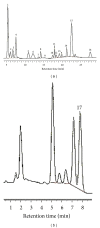Evaluation of fatty acid and amino acid compositions in okra (Abelmoschus esculentus) grown in different geographical locations
- PMID: 24171167
- PMCID: PMC3793589
- DOI: 10.1155/2013/574283
Evaluation of fatty acid and amino acid compositions in okra (Abelmoschus esculentus) grown in different geographical locations
Abstract
Okra has different uses as a food and a remedy in traditional medicine. Since it produces many seeds, distribution of the plant is also quite easy. Although seed oil yield is low (4.7%), since the linoleic acid composition of the seed oil is quiet high (67.5%), it can still be used as a source of (UNSAT) unsaturated fatty acids. In this study, samples of okra grown in four different locations were analyzed to measure fatty acid and amino acid compositions. The content of the lipid extraction ranged from 4.34% to 4.52% on a dry weight basis. Quantitatively, the main okra fatty acids were palmitic acid (29.18-43.26%), linoleic acid (32.22-43.07%), linolenic acid (6.79-12.34%), stearic acid (6.36-7.73%), oleic acid (4.31-6.98%), arachidic acid (ND-3.48%), margaric acid (1.44-2.16%), pentadecylic acid (0.63-0.92%), and myristic acid (0.21-0.49%). Aspartic acid, proline, and glutamic acids were the main amino acids in okra pods, while cysteine and tyrosine were the minor amino acids. Statistical methods revealed how the fatty acid and amino acid contents in okra may be affected by the sampling location.
Figures




References
-
- Prommakool A, Sajjaanantakul T, Janjarasskul T, Krochta JM. Whey protein-okra polysaccharide fraction blend edible films: tensile properties, water vapor permeability and oxygen permeability. Journal of the Science of Food and Agriculture. 2011;91(2):362–369. - PubMed
-
- András CD, Simándi B, Örsi F, et al. Supercritical carbon dioxide extraction of okra (Hibiscus esculentus L) seeds. Journal of the Science of Food and Agriculture. 2005;85(8):1415–1419.
-
- Savello PA, Martin FW, Hill JM. Nutritional composition of okra seed meal. Journal of Agricultural and Food Chemistry. 1980;28(6):1163–1166. - PubMed
-
- Vermerris W, Nicholson R. Phenolic Compound Biochemistry. Dordrecht, The Netherlands: Springer; 2006.
-
- Ewa C, Agnieszka G, Adam F, et al. The content of protein and of amino acids in Jerusalem artichoke tubers (Helianthus tuberosus L.) of red variety Rote Zonenkugel. Acta Scientiarum Polonorum, Technologia Alimentaria. 2011;10(4):433–441. - PubMed
Publication types
MeSH terms
Substances
LinkOut - more resources
Full Text Sources
Other Literature Sources

